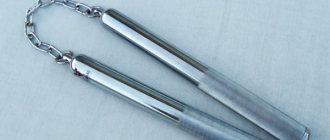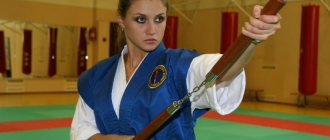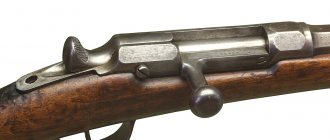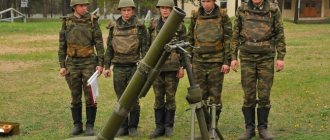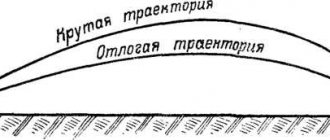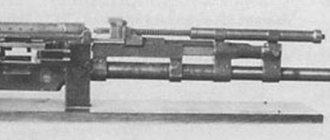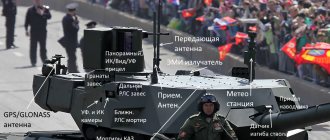In our world, everyone has seen on TV or even in reality how various martial arts masters train, demonstrating skillful use of some kind of sticks connected by a chain or rope. What can I say, in the famous cartoon “Teenage Mutant Ninja Turtles”, one of the main characters, a turtle named Raphael, owns just such a thing. These devices are called combat nunchucks; they are a type of Japanese bladed weapon with impact, shock-crushing and suffocating effects.
Let's take a closer look at what type of bladed weapon this is, where it came from, and what advantages and disadvantages it has.
What are nunchucks, what kind of weapon are they?
Nunchaku (nunchaku) are a type of oriental bladed weapon that has the following effects:
- Impact-crushing;
- Suffocating.
Today they are an object made of two short sticks that are tightly connected with a cord or chain. Professional martial artists prefer a corded connection, because under excessive loads the chain can simply break. The connecting elements in the nunchucks are threaded through channels in the frontal surfaces of the sticks. The chain can also be secured using metal fastening elements.
Part Dimensions
Before you make nunchucks from wood with your own hands, you need to know what size to cut the sticks and measure the length of the chain or laces. To calculate the size of the handles, the distance from the bone on the bent elbow to the middle of the palm is usually measured. This is a classic option for training. If the nunchucks will be used for protection and need to be placed in a pocket or purse, then the size can be equal to the length of two fists. In such cases, the connection is lengthened. There are also types of weapons that have sticks of different lengths. The choice is yours.
Next you need to measure the length of the chain or lace. It is optimal to start training with a connection length of four fingers or the size of a fist. This size will allow you to practice different techniques: clamps, mixed grips, squeezing and hand-to-hand interception. Later, you can try to make nunchucks with your own hands, using a short two-finger connection, which allows you to better control the movement of the free handle. There are also options with a long rope, well suited for making blocks. The size of such a connection is two fists or more.
The shape of the handles for training is conical. Combat nunchucks have a faceted shape with evenly cut ends. The thickness in a narrow place is equal to the phalanx of the little finger, and in a thick place - the phalanx of the index finger. Weight also varies - from simple wooden handles to specially weighted handles used for combat missions.
Historical facts of occurrence
Nunchakus, as we are used to seeing them, were invented in Okinawa, an archipelago that is part of Japan. There are other people living there, not the native Japanese, who speak a different language, this is especially noticeable among the older generation.
The Japanese language does not contain a word for nunchaku. To write the designation, a notation of the Katakan syllabary alphabet is used, this word is read as “nu-n-tya-ku.” Other languages use the following symbols for weapons:
- in Chinese there is a character that means “two-link flail” or “shuang-tse-gun”;
- in Okinawan - “nun-cha-kun”;
- in Japanese it is “so-setsu-kon”.
Many are of the opinion that the prototype of the nunchuk is a flail - utsu, which was used to thresh rice, but this is a misconception, the reason for this is some similarity. Okinawan utsu, however, and Chinese, Japanese, European with a human-sized handle, which allows you to beat out grain without bending too much.
The Okinawan kobujutsu arsenal contains a different weapon - the uchibo (battle flail), which is actually a modified peasant flail.
Options for what was the prototype of the nunchuk:
- Some are of the opinion that the devices are actually parts of the horse harness in the bit. Initially, the sticks were flat and curved, they looked like our collar, only made of wood. Then they came up with the idea of making them straight.
- It is also believed that the prototype of the weapon was a night watchman’s beater or a device that stripped the bark of a banana tree. Banana bark was used to make fabrics, which were in demand in the Okinawa archipelago.
- If we stick to another option, it turns out that the prototype of the nunchuk came to Okinawa with immigrants from China. Indirect confirmation of this is their designation, taken from the Chinese language.
In 1609, Okinawa or the Ryukyu Kingdom was occupied by the Japanese Principality of Satsuma, after which the kingdom became its vassal state. In 1879, Japan annexed Okinawa, but there weren't many Japanese samurai there. The Japanese banned the import and ownership of firearms. But this ban applied to ordinary citizens of the country, Okinawan nobles were allowed to carry swords (but not everyone could afford them), members of royal families, and princes were allowed to carry guns.
The noble class of the kingdom was previously prohibited from engaging in any business. The nobles were paid their salaries from the royal treasury. But at some point it became insufficient to support the families of nobles. Some noble families became impoverished to the point of poverty. To solve the problem, they were allowed to do:
- crafts;
- trade;
- agriculture.
The peasants had competitors, whom they were not happy about. The nobles had to fend off the attacks of the peasants, and since there were no special weapons, they used improvised means for defense. Someone thought of connecting two sticks with a rope, and that’s how weapons appeared - nunchucks.
Origin
It is significant that in the film “Fist of Fury,” Japanese students from the Bushido school look at the nunchaku, the technique of which Bruce Lee’s character demonstrates, with fear and even surprise. This is no coincidence. The origin of nunchaku is still controversial.
The Japanese insist that the ancestor of the nunchaku is a flail for threshing grain, but in shape it only vaguely resembles the nunchaku - it has a long handle and a short working section. If it were the size of a standard nunchuck, Okinawan peasants would have broken their backs during agricultural work.
The Chinese insist that the nunchaku is their invention. The Chinese origin of the nunchaku can be indicated by the fact that in kung fu, sectional weapons are widespread, there are a variety of flails, combat whips, and three-sectional nunchaku.
This dispute will probably be endless, but it is possible to come to the following compromise: the Chinese nunchaku that came to Japan were able to conquer the world precisely in their Okinawan version.
Varieties of nunchucks
Depending on what hand-to-hand combat technique their owner prefers, the preference for the size of the nunchuck’s components also depends. These samples of impact bladed weapons may have both identical and different sized parts. The dimensions of the component parts may also be affected by the circumstances for the required concealed carrying of the nunchucks. For this and other reasons, the size of the chains or ropes used to connect the two sticks may also differ.
A wide variety of wood is used to make sticks, which, as a rule, measure 20-30 cm. However, bamboo is considered to be the traditional material for making nunchucks. So, its cavities are filled with clay to increase mass, and their ends are connected with a strong rope. Actually, this material was used by peasants in ancient times, when they threshed rice grains with a bamboo flail.
Nunchakus have several varieties with different weights and shapes of sticks, which in turn are cone-shaped and cylindrical. Steel rings are inserted into the base of some varieties, and the second part of the stick, which is the main part and is held in the hand, is wrapped with a leather belt.
Nunchucks for beginners may turn out to be an unpleasant surprise for them, because without sufficient knowledge of the technique of using them, you can be seriously injured. In order for nunchucks to become an effective weapon, it is advisable to devote a lot of time to training and studying combat techniques.
Gallery[edit]
- Kusari
(chain) are used to connect the two halves of the nunchuck.
- Kikon-Bu
(bottom) of one nunchuk handle, showing
the kontei
(bottom) of the handle. - Jukon-Bu
(top) of the nunchaku, showing
the kontoh
(top of the handle) and
the kusari
(chain) that connects the two handles, or halves, of the nunchaku. - Close-up conto
(above) two nunchaku, showing
the kusari
(chain) on one and
the himo
(rope) and
ana
(hole) through which
the himo
on the other.
How to learn to use nunchucks
To master this weapon, you need to regularly train and improve your skills for 2-3 years. In addition to this, you need to develop:
- dexterity;
- intuition - to predict the movements of the enemy;
- coordination;
- speed of reactions.
Nunchakus are the most famous oriental military weapon.
Safety precautions
In order to learn how to use nunchucks, you need to master the basic technique under the strict supervision of a competent master in the gym. If you plan to train without the supervision of a trainer, you need to follow safety precautions. Using a weapon without proper training may result in injury.
- Buy a nunchuck for training. In stores you can find weapons made from soft materials (for example, foam). During training, the implement will often hit sensitive areas of the body, and the hard rods may leave bruises or cause serious contusions. Wooden weapons can be used only after mastering basic techniques and bringing them to automatism.
- Choose comfortable clothes. It should be free and in no case restrict movement. The optimal solution is a leotard without a T-shirt.
- Prepare the study room. It is necessary to free up space from furniture, taking into account the length of the weapon. Experts recommend starting your workouts outdoors rather than indoors so that you have more room to maneuver.
- Warm up before your workout. Before you begin the exercises, be sure to stretch the muscles of your torso and arms.
Training in a specialized gym together with a master allows you not only to maintain your health, but also to keep things, furniture and other valuables completely intact, since during training there is a possibility of damage to such items.
Links[edit]
- "" Definition of nunchaku "Oxford English Dictionary". Oxford University Press. Archived from the original on August 8, 2016. Retrieved July 11 +2016.
- Definition of "nunchuck", Mirriam-Webster Dictionary, accessed April 3, 2022.
- "Enter the Dragon case study". British Board of Film Classification. Archived from the original on May 10, 2022. Retrieved July 11 +2016.
- ↑
Active Interest Media, Inc.
(March 1975). "Black belt" . Black belt. Buyer's Guide
. Active Interest Media, Inc.: 10 -. ISSN 0277-3066. - "Karate Sticks". Dictionary. Archived from the original on April 9, 2016. Retrieved April 5, 2016.
- "Meet the guy who introduced Bruce Lee to nunchucks". Angry Asian man
. Archived from the original on July 25, 2022. Retrieved July 26, 2022. - https://www.bbc.co.uk/films/2001/03/20/fist_of_fury_1972_dvd_review.shtml
- ヌンチャクについて[About nunchuk] (in Japanese). Budoshop Japan. Archived from the original on 2013-04-20. Retrieved January 15, 2012.
- [1] thefreedictionary.com
- Donn F. Draeger and Robert W. Smith (1969). Integrated Asian martial art
. ISBN 978-0-87011-436-6. - Rethinking Japanese Cinema: Authorship, Genre, History, by Arthur Nolletti, David Desser, Indiana University Press, 1992, original from the University of Michigan, digitized May 5, 2008 ISBN 0-253-34108-6 ISBN 978-0-253- 34108-2
- "OKS Nunchaku". oks-online.com
. Archived from the original on 2009-04-06. - ↑
Alex Levitas.
"The Real History of Nunchaku". nunchaku.tripod.com
. Archived from the original on August 15, 2016. Retrieved July 27, 2016. - Kit, Wong Kiew (1996). The Art of Shaolin Kung Fu
. Elemental books. item 159. ISBN. 1-85230-789-7. - Demura, Fumio (10 May 1971). Nunchaku: Karate Weapons of Self-Defense. Black Belt Connection. ISBN 9780897500067 - via Google Books.
- Lagraver, Laurent. "Historique du Nunchaku de combat". nunchaku.free.fr
. Archived November 13, 2008. - "Saida Nunchaku - History". nunchakusaida.com
. Archived from the original on 2008-10-19. - "Nenbushi Historique". free.fr.
_ Archived from the original on 2009-04-07. - “**** FINCA is the International Federation of Nunchucks, Completed Martial Arts and Contemporary Art. ****" fincaweb.free.fr
. Archived from the original on November 14, 2008. - "WNA" nunchaku-do.org
. Archived from the original on 2009-04-08. - "WNA Kumite". nunchaku-do.org
. Archived from the original on 2008-12-22. - Taylor, Kim. "The Legality of Martial Arts Weapons in Canada". ejmas.com
. Archived from the original on May 14, 2008. - Regulations designating certain firearms and other weapons, weapon components and parts, accessories, ammunition magazines, ammunition and projectiles as prohibited or restricted, SOR/98-462 Archived November 4, 2010 at the Wayback Machine. Canlii. Retrieved 06/30/2010.
- Feststellungsbescheid de BKA of February 5, 2004, AZ KT21 / ZV 5-5164.02-Z-23/2004
- Waffengesetz Anlage 2 (Waffenliste), Abschnitt 1, Ziffer 1.3.8
- "Men exempt from prohibited gun sales". BBC News
. Retrieved January 21, 2022. - Reed, Craig. "TMNT: Rebirth [sic] of the Reptiles Return". Kung Fu Magazine
. Archived January 6, 2010. Retrieved December 27, 2009. - ^ ab "Possession of nunchucks is no longer a felony in Arizona". NPR.org
. Retrieved November 18, 2022. - "Penal Code Section 22010-22090". Archived from the original on 2012-01-26. Retrieved August 28, 2013.
- "Arizona Revised Statutes - 13-3101 - Definitions". Arizona Legislature
. Retrieved December 18, 2022. - State v. Swanton, 129 Ariz. 131 | Casetext" casetext.com
. Retrieved November 18, 2022. - "03-786 - Maloney v. Singas". govinfo
. Retrieved December 18, 2022. - Michael Martinez, Dan Simon and Augie Martin. "Nunchucks: California Police Use Martial Arts Equipment". CNN
. Retrieved September 10, 2022. - Peralta, Eyder (October 28, 2015). "Small California Town Gives Its Police Nunchucks as Non-Lethal Alternative". NPR
. Archived from the original on November 6, 2015. Retrieved November 9, 2015.
Techniques with nunchucks
Everyone, of course, remembers the films with Bruce Lee, where he masterfully wields them. Many boys in the yard, after watching the movie, made the same ones for themselves and tried to repeat his tricks. For some, techniques with nunchucks remained child's play, while others took up them at a professional level.
To master the technique of wielding a weapon, they turn to a master. If someone wants to do tricks with nunchucks on their own, without preparation, then they need to take care of their safety. Inept use is fraught with negative consequences for the health of the beginner. Transforming the nunchuck into an effective weapon is possible after dedicating a huge amount of time to training in studying martial art.
Exercising in the gym makes it possible not to damage furniture and things during training.
If it is not possible to visit a specialized establishment, then you should clear the room of furniture, taking into account the length of the rotating object. Another good option for a place to study is fresh air. Your own yard or a nearby park may be suitable. Tips for beginners:
- The first classes are carried out with soft or foam rubber devices. Wooden nunchucks are used when a person has already mastered the basic exercises.
- You need to choose loose clothing that does not restrict movement; the best option is a tights without a T-shirt, this way the body will be hardened at the same time.
For beginners, weapons from . This French company produces quality products:
- costumes for sports and martial arts.
- all kinds of sports equipment, including nunchucks.
For example, the company produces PVC nunchucks covered with foam material, which ensures safe training. The reinforced cord guarantees a good grip on the weapon. The size of the poles is 73 cm, the cord is 13 cm. They are guaranteed for 24 months.
The main secret of clear, precisely choreographed movements is their repeated repetition, so they remain in the subconscious, that is, “put on a reflex.” Methodological recommendations for mastering weapon techniques:
- First of all, they study the trajectory of movements with chopsticks at low speed, sufficient to maintain tension on the cord.
- Having developed the trajectory of movement, the speed of performing techniques with weapons gradually increases.
- When the movements gain clarity and precision, they begin to practice techniques, increasing both the speed and force of striking.
You can purchase or make your own several types of nunchuck:
| Kinds | Training method |
| Lungs | They are used at the beginning of training and to develop new techniques. Lighter sticks cause less damage. |
| Combat | Used after establishing movements with a light type of device. |
| Heavy | Used to increase the sharpness and force of impact. |
In practicing techniques using fighting sticks, you need to spend more time in training.
Sports associations[edit]
| In this section too many links to primary sources . |
Since the 1980s, various international sports associations have been created that have organized the use of nunchaku as a contact sport. [16] [17] Existing associations typically conduct "semi-contact" fights, in which hard strikes are prohibited, as opposed to "contact" fights. On the other hand, Full-Nunch matches have no restrictions on the severity of hits, and knockouts are allowed. [18]
- American Style Nunchaku Federation (ASNF)
: Founded by Grand Master Michael Burke in 1992 and specializes in tournament and kata forms. - North American Nunchaku Association (NANA):
Founded in 2003 in California by Sensei Chris Pellitteri, NANA teaches all aspects of nunchaku, traditional and free style, singles and doubles. - World Amateur Nunchaku Organization (WANO):
founded by Pascal Verhill in France in 1988. - Fédération Internationale de Nunchaku de Combat et Artistique
(FINCA):
Founded by Raphaël Schmitz in France in 1992 as a result of the merger of the dissolved associations WANO and FFNS ( French Federation of
Nunchaku Sports).
Its current name is the Federation Internationale Nunchaku, Complete Martial Arts and Contemporary and Related Arts
(FINCA). [19] The fight according to FINCA rules lasts two rounds of two minutes. There is no need to change either the nunchaku branch or the hand before the strike, only the correct recovery. There are no stops during the fight, except for losing, rising or penalties. - World Nunchaku Association (WNA):
Founded by Milko Lambrecht in the Netherlands in 1996.
[20] The WNA uses yellow and black plastic training nunchucks and protective headgear. They have their own belt color system where members earn colored stripes on their belts instead of fully colored belts. One side of the belt is yellow and the other black, so during competitions competitors can be distinguished by the visible side of the belt. The WNA fighting rules correspond to the kumite
of the Nunchaku-do discipline. [21] This is a two-minute "touch fight" in which technical skill is very important. After each point scored, the fight stops and the fighters return to their starting position. - International Techdo Nunchaku Association (ITNA):
founded by Daniel Althaus in Switzerland in 2006. ITNA determines bouts in the last two rounds lasting 2:30. There are no stoppages during the round except for losses, rises or penalties. Between two strikes, the fighter must change hand and branch of the nunchaku before striking again, unless he is blocking. - Nunchaku-en-Savate (ARSIC-International):
First introduced by Jean-Noël Einard, Professor of Savate, pioneer of FFBFSDA Savate in the USA. This sport combines the Savate technique with Nunchaku, similar to Savate combined with la Canne. A revival of nunchaku-en-savate occurred in Ivory Coast in the late 1970s. It was taught in Savate self-defense classes. This sport appeared in the USA in 1983.
Responsibility for use
The expert's conclusion will determine whether this or another item is considered a weapon, which also applies to nunchucks. The decisive role in resolving this issue will depend on the material from which they were made. With their help, considerable harm is caused to human health, because these are the weapons of Japanese samurai and ninjas, therefore in Russia they are considered edged weapons.
If a person constantly trains with them, then the place of such sports equipment is in the gym, and it cannot be taken out of there. Exceptional cases include transportation for performances. Wearing and using nunchucks in public places, according to the Criminal Code of the Russian Federation, threatens legal liability.
The most famous weapon in eastern martial art is the nunchuck.
When starting to master them, know that these are edged weapons with destructive power and the law provides for an article for illegal carrying. The essence of the nunchuk is whip strikes, and the variety in the methods of interception is simply options for bringing the weapon into the desired position, and each individual school of martial arts has its own varieties of this weapon.
The masterful use of such sticks on a rope hypnotizes both ordinary spectators and stops an aggressive intruder.
Formal styles[edit]
Nunchaku is most often used in Okinawan kobudo and karate, but is also used in eskrima (more precisely, Tabak-Toyok, a similar, although different, Filipino weapon, is used in contrast to Okinawan nunchaku) and Korean hapkido. . Its application differs in each style. Traditional Okinawan forms use sticks primarily for gripping and fixing. Filipino martial artists use it in much the same way as a stick - striking takes precedence. Korean systems combine offensive and defensive movements, so they teach both locks and strikes. Other proprietary nunchaku systems are also used in sembkal (Iranian monolingual fighting style), which delivers lethal blows in defense and attack. Nunchaku is often the first weapon a student wields to teach restraint and posture, as the weapon can hit the wielder more than the opponent if not used properly.
The Nunchaku is usually held in one hand, but can also be used in pairs. It can be spun using hardened handles for blunt force, and can be chained around an attacking weapon to immobilize or disarm an opponent. Nunchaku training was noted [ by whom?
] to increase hand speed, improve posture and condition the practitioner's hands. Thus, it is a useful training weapon.
